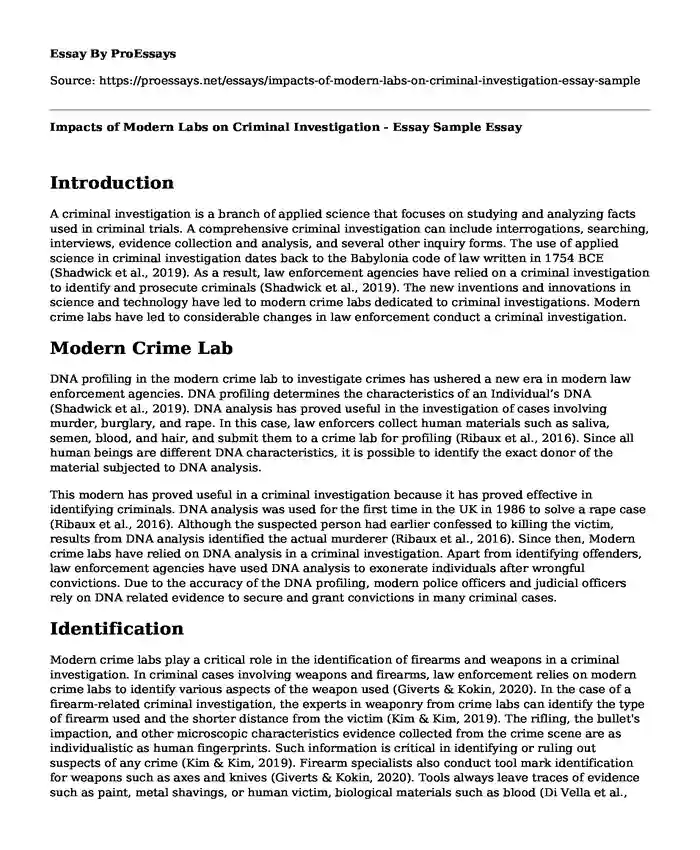Introduction
A criminal investigation is a branch of applied science that focuses on studying and analyzing facts used in criminal trials. A comprehensive criminal investigation can include interrogations, searching, interviews, evidence collection and analysis, and several other inquiry forms. The use of applied science in criminal investigation dates back to the Babylonia code of law written in 1754 BCE (Shadwick et al., 2019). As a result, law enforcement agencies have relied on a criminal investigation to identify and prosecute criminals (Shadwick et al., 2019). The new inventions and innovations in science and technology have led to modern crime labs dedicated to criminal investigations. Modern crime labs have led to considerable changes in law enforcement conduct a criminal investigation.
Modern Crime Lab
DNA profiling in the modern crime lab to investigate crimes has ushered a new era in modern law enforcement agencies. DNA profiling determines the characteristics of an Individual’s DNA (Shadwick et al., 2019). DNA analysis has proved useful in the investigation of cases involving murder, burglary, and rape. In this case, law enforcers collect human materials such as saliva, semen, blood, and hair, and submit them to a crime lab for profiling (Ribaux et al., 2016). Since all human beings are different DNA characteristics, it is possible to identify the exact donor of the material subjected to DNA analysis.
This modern has proved useful in a criminal investigation because it has proved effective in identifying criminals. DNA analysis was used for the first time in the UK in 1986 to solve a rape case (Ribaux et al., 2016). Although the suspected person had earlier confessed to killing the victim, results from DNA analysis identified the actual murderer (Ribaux et al., 2016). Since then, Modern crime labs have relied on DNA analysis in a criminal investigation. Apart from identifying offenders, law enforcement agencies have used DNA analysis to exonerate individuals after wrongful convictions. Due to the accuracy of the DNA profiling, modern police officers and judicial officers rely on DNA related evidence to secure and grant convictions in many criminal cases.
Identification
Modern crime labs play a critical role in the identification of firearms and weapons in a criminal investigation. In criminal cases involving weapons and firearms, law enforcement relies on modern crime labs to identify various aspects of the weapon used (Giverts & Kokin, 2020). In the case of a firearm-related criminal investigation, the experts in weaponry from crime labs can identify the type of firearm used and the shorter distance from the victim (Kim & Kim, 2019). The rifling, the bullet's impaction, and other microscopic characteristics evidence collected from the crime scene are as individualistic as human fingerprints. Such information is critical in identifying or ruling out suspects of any crime (Kim & Kim, 2019). Firearm specialists also conduct tool mark identification for weapons such as axes and knives (Giverts & Kokin, 2020). Tools always leave traces of evidence such as paint, metal shavings, or human victim, biological materials such as blood (Di Vella et al., 2017).
Whether on a door, a body, or a safe, tool marks left in crime scene help identify a specific weapon. Apart from identifying firearms, law enforcement also relies on modern crime labs to conduct a post-mortem examination of a dead body (Ribaux et al., 2016). Post-mortem investigation involves a surgical procedure and thorough analysis of a body to determine the manner, mode, and cause of death (Latham & Miller, 2019). In murder cases, autopsy helps law enforcers determine whether the death was natural or unnatural, time since death and identifying the deceased (Kim & Kim, 2019). This information is critical in helping police officers to identify individuals responsible for each particular case.
Conclusion
It is evident from the discussion above that modern crime lab has profound changes in how law enforcers conduct criminal investigations. These labs employ modern science and technology to identify or rule out suspects in criminal cases. DNA profiling, weapon identification, and post-mortem analysis conducted in modern crime labs provide critical information to identify and prosecute criminals.
References
Di Vella, G., Grattagliano, I., Curti, S., Catanesi, R., Sullivan, M. K., & Tattoli, L. (2017). Multiple stab wounds: understanding the manner of death through the psychological autopsy. Clin Ter, 168(4), e233-239. https://pubmed.ncbi.nlm.nih.gov/28703837/
Giverts, P., & Kokin, A. V. E. (2020). The Problem of Subclass Features in Forensic Firearms Identification. Forensic Casework, 15(1), 109-117.
https://core.ac.uk/download/pdf/322550504.pdf
Kim, Y. S., & Kim, T. E. (2019). Review of legal codes governing administrative death investigations and autopsy by administrative order. Korean Journal of Legal Medicine, 43(1), 1-6.
https://synapse.koreamed.org/DOIx.php?id=10.7580/kjlm.2019.43.1.1
Latham, K. E., & Miller, J. J. (2019). DNA recovery and analysis from skeletal material in modern forensic contexts. Forensic Sciences Research, 4(1), 51-59. https://www.tandfonline.com/doi/abs/10.1080/20961790.2018.1515594
Ribaux, O., Crispino, F., Delémont, O., & Roux, C. (2016). The progressive opening of forensic science toward criminological concerns. Security Journal, 29(4), 543-560. https://link.springer.com/article/10.1057/sj.2015.29
Shadwick, J. T., King, W. R., Zhang, Y., Matusiak, M. C., & Campbell, B. A. (2019). Assessing best practices in crime lab structure, processes, and performance. Policing International Journal. 42(5), 35-40. https://www.emerald.com/insight/content/doi/10.1108/PIJPSM-12-2018-0181/full/html.
Cite this page
Impacts of Modern Labs on Criminal Investigation - Essay Sample. (2024, Jan 01). Retrieved from https://proessays.net/essays/impacts-of-modern-labs-on-criminal-investigation-essay-sample
If you are the original author of this essay and no longer wish to have it published on the ProEssays website, please click below to request its removal:
- Criminal Law Story by the Canadian Press
- Drug Courts Essay Example
- Essay Sample on Current Crime in South Africa
- Essay Example on The Seven Five: The Story of Michael Dowd's Crimes & Redemption
- Juvenile Corrections: Probation and Beyond - Essay Sample
- 3 Contemporary Issues Impacting Correctional Management - Essay Sample
- Math: A Necessity in the 21st Century - Essay Sample







